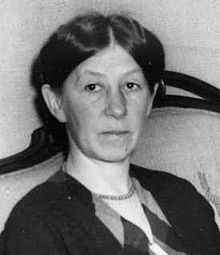Ellen Gleditsch
Ellen Gleditsch (born December 29, 1879 in Mandal , Norway , † June 5, 1968 in Oslo ) was a Norwegian chemist .
Life
Ellen Gleditsch was the oldest of 11 children and grew up in an educated middle-class family - her father was a natural history teacher, her mother an intellectual who was committed to women's rights. Although she finished high school as the best of her year, she was excluded from the entrance exams for university studies as a woman, so that in 1897 she completed an apprenticeship as a pharmacist . Through her work as a pharmacology assistant, she was able to obtain a non-academic title in chemistry and pharmacology in Tromsø in 1902 , which finally enabled her to take up chemistry studies at the University of Oslo (1902–1907). In the 1940s Gleditsch worked underground after she had previously supported scientists from Germany who had been driven into exile. She offered her laboratory as a shelter, hid persecuted people at home and conveyed messages for resistance groups. Several arrests were made after a search of her laboratory in 1943.
Research activity
1907–1912 Gleditsch went to Paris and worked there as Marie Curie's assistant in the laboratory at the Institut du Radium , while studying at the Sorbonne University . In Curie's laboratory, she was able to work on her own projects and began researching the chemical composition of radioactive substances. In 1909, she published her first scientific article on the half-life of radium . In 1912 she returned to the University of Oslo, where she was employed as a lecturer and researcher. Two years later she received a research grant to go to the United States and continue her research there in the better equipped radiochemistry laboratory at Yale University. She worked in Bertram Boltwood's laboratory, where she completed her research on the half-life of radium, which she calculated to be 1686 years. This value remained unchallenged for 35 years until researchers corrected it to 1620 years with more precise measurement options. In 1916 she went back to the University of Oslo, where she taught for the rest of her career, but was not habilitated until 1929 . In the 1920s Gleditsch initiated the first research group on radioactivity in Norway, and between 1916 and 1946 they tried to set up a laboratory for radiochemistry at the University of Oslo. During this period, in which she mainly worked on the determination of the atomic weight of chlorine, she devoted considerable resources to setting up the laboratory through networking, grant applications, trips abroad, teaching and graduate support. The Nuclear Chemistry Department at the Chemistry Institute at the University of Oslo emerged from Gleditsch's research group. Because of the difficulties that Gleditsch herself faced in her studies and her academic career, she committed herself to encouraging young women to take up scientific activities. Between 1926 and 1929 she was chairman of the International Federation of Women Scientists. Gleditsch published around 150 articles and books, including some popular science.
Awards
- 1906 Award from Queen Josephine's legacy chemistry in France
- Honorary doctorates at Smith College Sorbonne and the University of Strasbourg
literature
- Torleiv Kronen and Alexis Pappas: Ellen Gleditsch: et liv i forskning og medmenneskelighet . Oslo, 1987. ISBN 82-588-7145-5 . (Norwegian)
- Annette Lykknes, Helge Kragh, Lise Kvittingen, Lise: Ellen Gleditsch: Pioneer Woman in Radiochemistry . Physics in Perspective, Volume 6, Issue 2, pp. 126–155 (2004) (English)
Web links
- Biography: Ellen Gleditsch (English)
Individual evidence
- ↑ epigenesys.eu: Ellen Gleditsch
- ↑ Gleditsch, Ellen. In: Oakes, Elizabeth H. International Encyclopedia of Women Scientists. New York, 2002. p. 134.
- ↑ a b Annette Lykknes, Helge Kragh, Lise Kvittingen: Ellen Gleditsch: Pioneer Woman in Radiochemistry, Physics in Perspective, June 2004, Volume 6, Issue 2, pp 126-155.
| personal data | |
|---|---|
| SURNAME | Gleditsch, Ellen |
| BRIEF DESCRIPTION | Norwegian chemist |
| DATE OF BIRTH | December 29, 1879 |
| PLACE OF BIRTH | Mandal |
| DATE OF DEATH | 5th June 1968 |
| Place of death | Oslo |
